You can measure your sleep cycles using wearable devices that achieve 65-75% accuracy through sophisticated sensors monitoring heart rate variability, movement patterns, and breathing rhythms. Consumer trackers like the Oura Ring, Apple Watch, and Samsung Galaxy Watch use photoplethysmography and accelerometry to detect sleep stages, though they struggle with precise classification without EEG data. These devices excel at tracking overall sleep duration but face challenges distinguishing between light sleep and wake periods, particularly in individuals with sleep disorders. Understanding these limitations will help optimize your sleep tracking experience.
Understanding Sleep Architecture and Why Measurement Matters
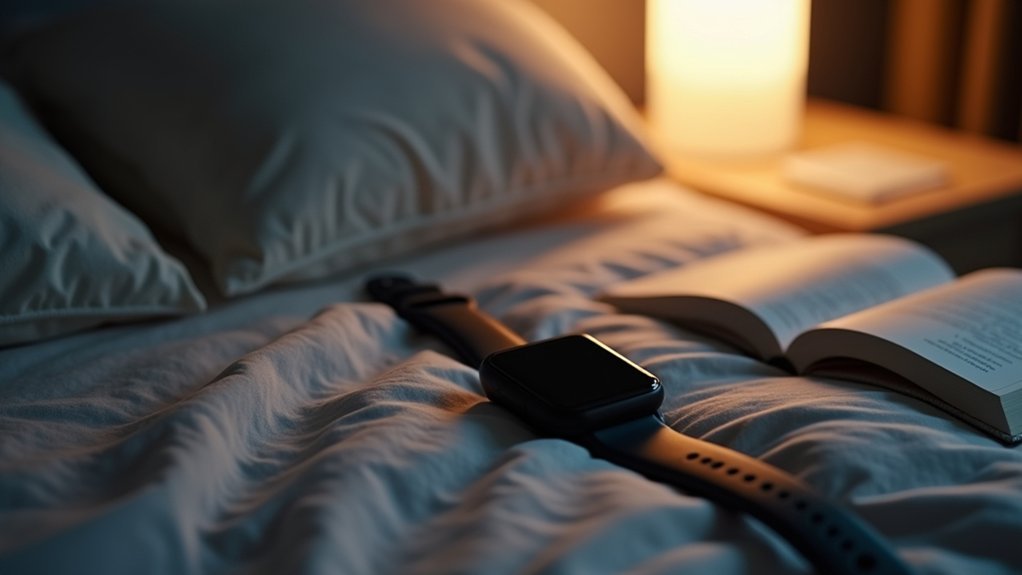
When you drift off to sleep each night, your brain doesn’t simply shut down—it cycles through a sophisticated sequence of stages that form what scientists call sleep architecture.
This structure involves four main stages: three NREM phases and REM sleep, repeating multiple times throughout the night.
Understanding these cycles matters because sleep quality depends on more than just duration—it’s about getting adequate time in each restorative stage.
Stage 3 NREM provides physical recovery and immune support, while REM sleep consolidates memories and regulates emotions.
When sleep disorders disrupt this architecture, you’ll experience impaired functioning despite spending enough time in bed.
Measuring your sleep stages helps identify problems and optimize interventions for better health outcomes. Each complete cycle typically lasts about 90-120 minutes, resulting in four to five complete cycles during a full night’s rest.
Types of Consumer Sleep Tracking Devices: Wearables, Nearables, and Airables
The consumer sleep tracking market offers three distinct categories of devices, each using different approaches to monitor your nightly rest.
Sleep tracking technology has evolved into three main device categories, each offering unique methods to analyze and improve your sleep quality.
Wearables like the Oura Ring 4, Apple Watch Series 8, and Fitbit Sense 2 attach directly to your body, using PPG sensors and accelerometers to track movement and blood flow. They’re convenient but may feel comfortable during sleep.
Nearables such as the Withings Sleep Tracking Mat and Amazon Halo Rise sit close to you without physical contact, using pressure sensors or radar technology to detect subtle body movements. They’re less intrusive than wearables but have mattress thickness limitations for optimal performance.
Airables rely on smartphone apps like SleepScore and Pillow, analyzing environmental sounds and data through your phone’s microphone. They’re accessible but offer lower precision than other categories.
How Modern Devices Detect and Classify Sleep Stages
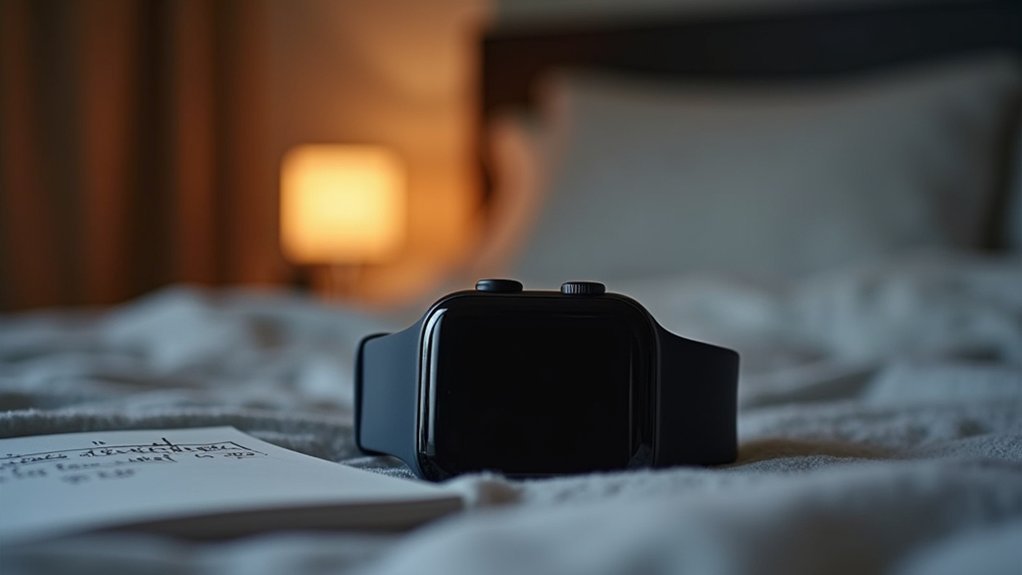
Your wearable sleep tracker relies on multiple sensor technologies to detect and classify different stages of sleep throughout the night.
These devices use combinations of EEG brain wave monitoring, PPG heart rate sensors, and accelerometry motion detection to distinguish between light sleep, deep sleep, REM sleep, and wakefulness.
However, you’ll find that accuracy varies considerably depending on which sensing method your device uses and how well it can overcome the inherent challenges of classifying complex sleep stages. Consumer-grade devices like Fitbit and OURA rings typically achieve 50%-70% accuracy in sleep stage identification using their combined sensor configurations.
Sensor Technologies and Methods
Although sleep appears as a simple period of rest, modern wearable devices employ sophisticated sensor arrays to decode the complex physiological changes occurring throughout your night.
Your wearable primarily uses these four core sensor technologies:
- Tri-axial accelerometers – Track movement in three dimensions to distinguish between sleep and wake states based on activity levels.
- Photoplethysmography (PPG) sensors – Monitor heart rate and heart rate variability changes that fluctuate across different sleep stages.
- Skin temperature sensors – Measure peripheral temperature fluctuations corresponding to circadian rhythms and sleep shifts.
- Ambient light sensors – Assess environmental light exposure to contextualize sleep data and detect sleep onset timing.
These sensors work together, feeding continuous data streams into machine learning algorithms that process your physiological patterns to identify light sleep, deep sleep, and REM phases with moderate accuracy compared to clinical polysomnography.
However, it’s important to understand that consumer sleep technologies are not yet validated for diagnosis and may overestimate certain sleep metrics compared to clinical standards.
Classification Accuracy Challenges
While these sensors capture vast amounts of physiological data throughout the night, translating raw measurements into accurate sleep stage classifications presents significant challenges for wearable manufacturers.
Most devices show only moderate agreement with gold-standard polysomnography, with even top performers like SleepRoutine achieving macro F1 scores around 0.69. You’ll find sensitivity ranges widely across devices, typically hitting 50-86% for different sleep stages.
The Oura Ring currently leads major wearables with 79.5% deep sleep detection sensitivity and 68.6% wake detection accuracy.
However, methodological issues complicate comparisons—sleep stages change every 30 seconds, making accuracy highly dependent on epoch alignment. Research from the Division of Sleep and Circadian Disorders reveals significant variability in accuracy when comparing different commercial wearable devices against established sleep monitoring standards.
Apple Watch tends to overestimate light and deep sleep, while legacy motion-only devices frequently misclassify motionless wake periods as sleep.
Accuracy Benchmarks: Comparing Consumer Trackers to Medical-Grade Equipment
You’ve likely wondered how your smartwatch or fitness tracker compares to the gold standard sleep lab equipment that doctors use.
Polysomnography (PSG) remains the benchmark against which all consumer sleep trackers are measured, using sophisticated sensors and brain wave monitoring that far exceeds what’s possible on your wrist.
When researchers analyze performance metrics like macro F1 scores and Cohen’s kappa values, they’re fundamentally determining whether your device can deliver clinically meaningful data or if it’s just providing rough estimates. The Oura Ring Gen 4 has demonstrated accurate data capture that matches polysomnography sleep lab tests, setting a new standard for consumer wearable devices.
PSG Vs Wearables
When comparing your consumer sleep tracker to medical-grade polysomnography (PSG), you’re fundamentally pitting convenience against clinical precision. PSG monitors multiple biological signals—brain activity, eye movement, muscle tone, heart rate, and respiration—delivering unmatched accuracy for sleep stage analysis.
Your wearable relies on accelerometers and heart rate sensors, translating this limited data into sleep estimates through algorithms. Recent research from Brigham and Women’s Hospital validates that wearable technology offers a less intrusive solution for sleep measurement while maintaining reasonable accuracy.
Here’s what the accuracy benchmarks reveal:
- Oura Ring outperforms Apple Watch and Fitbit by 5-10% in four-stage sleep detection
- High sensitivity (>0.93) for detecting sleep but low specificity (0.18-0.54) for wake detection
- Garmin devices generally underperform compared to other wearables in sleep/wake metrics
- Wearables struggle with disrupted sleep, performing worse on nights with poor sleep quality
Performance Metrics Analysis
Understanding how your sleep tracker stacks up against medical equipment requires examining specific performance metrics that reveal both capabilities and limitations.
Consumer wearables achieve 65-75% accuracy when combining accelerometry with photoplethysmography, using weighted F1 scores and Cohen’s kappa for evaluation.
You’ll find significant device variability in performance. Apple Watch 8 and Galaxy Watch 5 excel in specific settings, while Polar devices offer better specificity than Garmin models.
However, Garmin detects almost all sleep time but misses wake moments.
Your wearable typically shows high sensitivity but low specificity, meaning it’ll overestimate sleep time and underdetect wakefulness.
Nearable devices like SleepRoutine score higher (0.7106 macro F1) than traditional wearables, while others like Pillow perform poorly (0.2830). Commercial trackers may actually outperform actigraphy, the clinical sleep test that requires professional administration and specialized equipment access.
Performance Analysis of Leading Sleep Tracking Devices
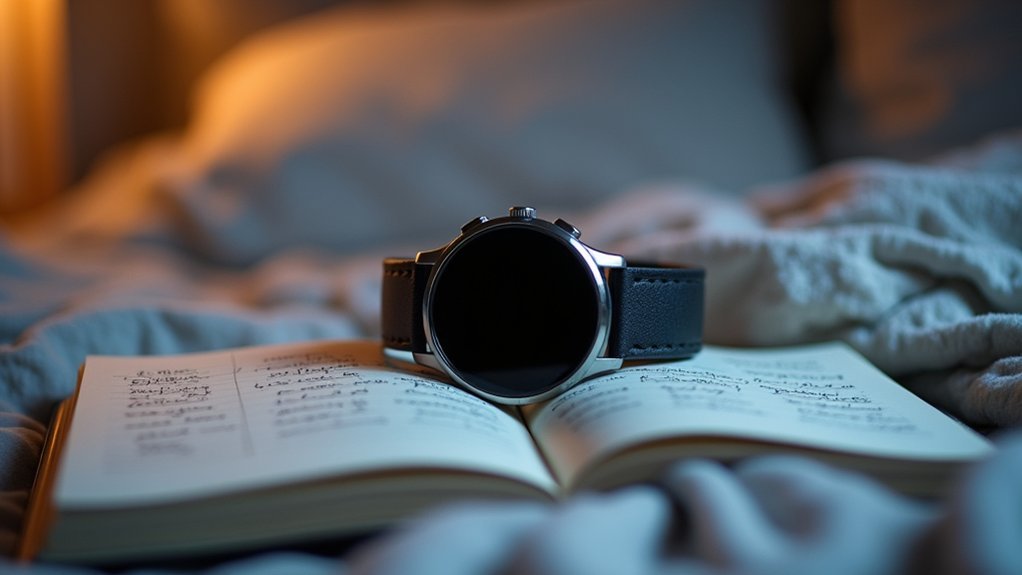
Although sleep tracking technology has evolved rapidly, the performance gap between different device types remains significant when it comes to accuracy and real-world usability.
You’ll find that device selection dramatically impacts your sleep monitoring experience and data quality.
Here’s how leading devices stack up in real-world performance:
- Muse S Headband delivers the highest accuracy through EEG brain wave monitoring, providing clinically-validated sleep stage detection that matches laboratory standards.
- Oura Ring and Samsung Galaxy Ring excel in comfort and convenience while maintaining robust accuracy through optical sensors and advanced algorithms.
- Whoop 4.0 Band offers personalized insights with actionable recommendations, focusing on sleep stages, HRV, and respiratory rate tracking.
- Non-wearable trackers like Eight Sleep Pod 3 provide unobtrusive monitoring with environmental controls for ideal sleep conditions. Wearable devices generally demonstrate superior accuracy compared to non-wearable alternatives due to their direct skin contact for sensor readings.
The Role of Heart Rate Variability in Sleep Quality Assessment
Beyond basic sleep stage detection, your device’s ability to track heart rate variability (HRV) provides one of the most scientifically validated windows into sleep quality assessment.
HRV measures variations in time between heartbeats, reflecting your autonomic nervous system’s balance during sleep. Higher HRV indicates better cardiovascular adaptability, while lower readings suggest poor parasympathetic functioning.
Your HRV naturally fluctuates throughout sleep cycles—decreasing during deep NREM sleep when parasympathetic activity dominates, then increasing during REM sleep as sympathetic influence rises.
Factors like body temperature, movement, and brief awakenings affect these patterns. Low HRV scores can reveal sleep disorders or underlying health issues. These underlying issues may indicate fatigue, dehydration, stress, or illness affecting your recovery.
Modern wearables use advanced algorithms to analyze this data, offering personalized insights that help you optimize sleep hygiene and overall well-being.
Common Limitations and Error Margins in Consumer Sleep Technology
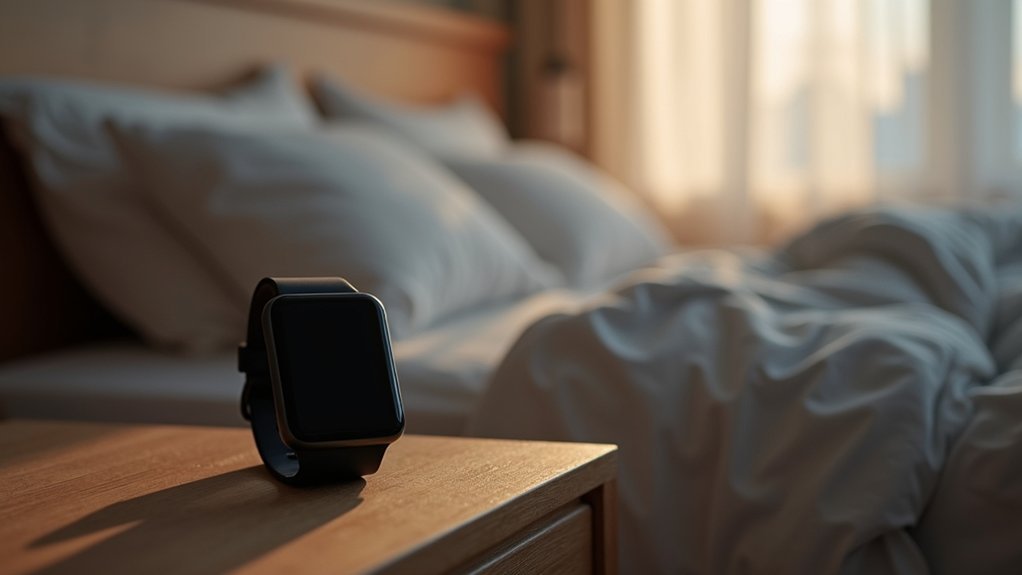
While your wearable device provides valuable sleep insights, it’s essential to recognize the inherent limitations that can affect the accuracy of your sleep data. Consumer devices can’t directly measure brain waves like clinical polysomnography, instead relying on motion sensors and heart rate monitors as proxies for sleep stages.
Key accuracy challenges you’ll encounter include:
- Sleep stage misclassification – Devices struggle to differentiate light, deep, and REM sleep without EEG data, with accuracy scores ranging from 0.28 to 0.71.
- Overestimated sleep duration – Wearables frequently misclassify wakefulness as sleep, inflating total sleep time.
- Poor performance with sleep disorders – Over 50% of wake periods can be misclassified in individuals with insomnia or sleep apnea.
- Limited fragmented sleep detection – Brief awakenings common in sleep disorders often go undetected.
Consumer sleep trackers fundamentally rely on measured inactivity to estimate sleep patterns rather than providing direct physiological measurements of actual sleep states.
Future Developments in Wearable Sleep Monitoring Technology
As wearable sleep technology continues to evolve, you’ll soon benefit from groundbreaking advancements that promise to address many of today’s accuracy limitations. Miniaturized sensors will capture multiple bio-signals with enhanced precision while consuming less power for extended monitoring. You’ll see innovative form factors beyond traditional wristbands, including smart rings, headbands, and even non-wearable alternatives like smart mattresses. Bioresorbable electronics will enable temporary monitoring devices that safely dissolve after fulfilling their sleep study purpose. AI-powered analytics will provide personalized insights and predictive health detection capabilities.
| Technology Advancement | Benefit to Users |
|---|---|
| Multi-modal sensing (brain activity, respiration) | More accurate sleep stage detection |
| Smart alarm enhancement | Wake up during ideal sleep phases |
| Clinical integration | Professional sleep disorder screening |
These developments will transform sleep monitoring from basic tracking into all-encompassing health management tools.
Frequently Asked Questions
Can I Use Multiple Sleep Trackers Simultaneously for Better Accuracy?
You can use multiple sleep trackers simultaneously, and they’ll provide complementary data that helps cross-validate sleep detection. However, you’ll face synchronization challenges and conflicting outputs between devices.
Do Sleep Trackers Work Accurately for People With Sleep Disorders?
Sleep trackers don’t work accurately if you have sleep disorders like insomnia. They’ll struggle differentiating your sleep from wakefulness since you remain still while trying to fall asleep, reducing accuracy considerably.
How Often Should I Charge My Wearable Sleep Tracker?
You should charge your wearable sleep tracker every 1-3 days during daytime hours, like while showering or eating, to avoid missing nighttime sleep data when the device needs continuous wear.
Will My Sleep Tracker Data Be Shared With Insurance Companies?
Your sleep tracker data won’t automatically be shared with insurance companies. However, some insurers offer discounts if you voluntarily share your data through specific programs, but you’d need to actively opt-in first.
Can Sleep Trackers Detect Sleep Apnea or Other Breathing Issues?
Your sleep tracker can detect some signs of sleep apnea with moderate accuracy, but it’s not reliable enough for medical diagnosis. These devices work best for general monitoring rather than diagnosing specific breathing disorders.
In Summary
You’ll find that modern wearables offer valuable insights into your sleep patterns, though they can’t match medical-grade accuracy. While current devices excel at tracking sleep duration and basic stages, you shouldn’t rely solely on their data for serious sleep disorders. As technology advances, you’ll see improved sensors and AI algorithms that’ll provide more precise measurements. Use these tools as helpful guides, but remember they’re supplements to, not replacements for, professional sleep assessment.

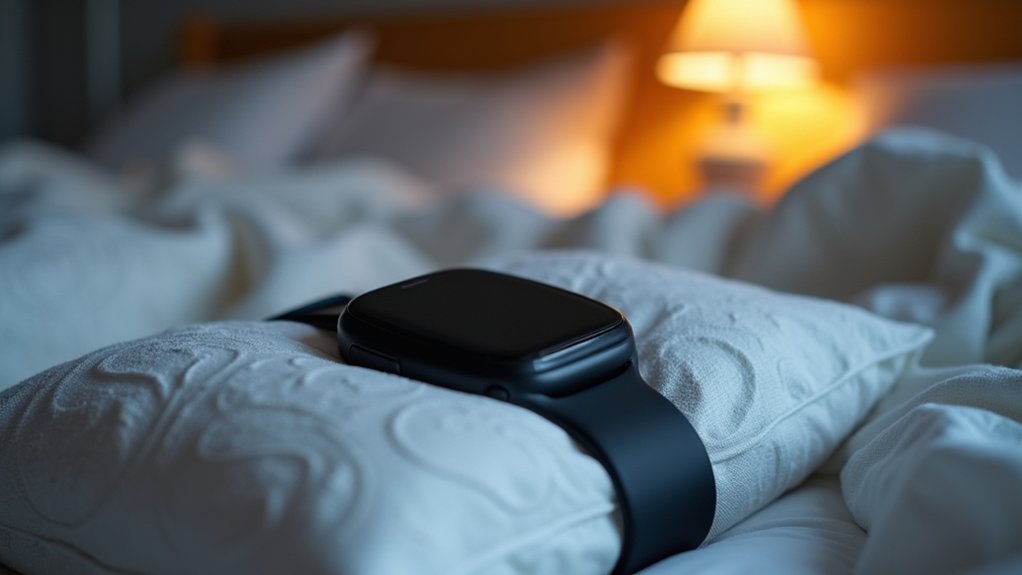



Leave a Reply